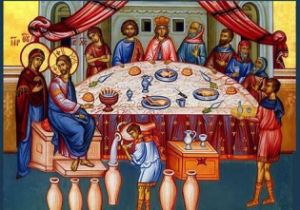Holy Matrimony

Marriage is a sacrament of the Church through which the union of man and woman is blessed by God. That Jesus chose a wedding to enact His first earthly miracle is the most profound indication of the dignity attributed to the union of man and woman by God. The primary purpose of marriage is to unite two people into a communion of love for their mutual companionship and as an aid to theosis, or sanctification, being the attainment of the Eternal Kingdom. As read by the priest at the end of the service “take their Crowns unto Your kingdom and preserve them blameless, guileless and unstained unto the ages of ages. Amen.”
In marrying, spouses learn God’s commandment to “love thy neighbour as thy self.” In giving up their individual will and accepting the other’s will, the spouse learns to sacrifice for the other, just as Christ sacrificed Himself for the Church. The Marriage service is full of ritual and symbolism that reflects the theology of the church. It is comprised of two parts being the Betrothal Service (Engagement) with the official blessing of the rings, and the Marriage Service with the crowning of the Bride and Groom.
Orthodox marriage is not viewed as a legal contract, and there are no oaths or vows made. Prayers are read asking God to set an unbroken unity on the couple blessing them with peace, oneness of mind and a spirit of truth and love. Praying for their salvation, preserving them in the faith and granting them an honourable marriage.
The celebration of Marriage contains the same elements as the sacraments of Baptism and Chrismation, as well as the Eucharist:
(1) The offering – in the Eucharist the bread and wine is offered whilst in marriage the Church offers the bride and groom who in turn offer themselves to one and another and to God;
(2) The anamnesis, or memorial, in the Eucharist consists of grateful evocation of Christ’s whole work of salvation and in the celebration of marriage we recall with gratitude: the historic Old Testament miracles performed by God for married couples, the mystical model of Christ’s marriage to the Church, and the wedding in Cana;
(3) The epiclesis or invocation in which the Holy Spirit is asked to effect the same miracles on this particular occasion. In the Eucharist it is the transformation of the bread and wine into the Body and Blood of Christ whilst in marriage it is the “crown them with glory and honour” in which they are transformed into a living cell of Christ’s Body. The crowns placed on the couple also symbolise victory for those who “have fought the good fight” of the Christian life and the couple are crowned king and queen of their own household. At the same time the hymns remind them that they are to live virtuous lives as did the Saints and Martyrs whose faith and sacrifice they are called to emulate. In this way they become witnesses (martyrs) to the faith and heirs of the Kingdom;
(4) The communion, or the couple’s participation in the life of the Kingdom. The man and woman united by the Holy Spirit are now united in Christ. The cup of wine, from which the bride and the bridegroom drink together, is shared as a sign of that unity. It is also in remembrance of the miraculous wine at the wedding in Cana. In addition, it is a relic of the practice which up until the fifteenth century included Communion with presanctified Gifts.
The Priest performs the Dance of Isaiah whilst holding the Holy Gospel in his hands and leading the couple three times around the ceremonial table. This highlights the Church’s prayerful desire that the couple will walk through life led by the infallible and secure Word of God and inspired by the Church.
Source: Lychnos December 2019 – January 2020
